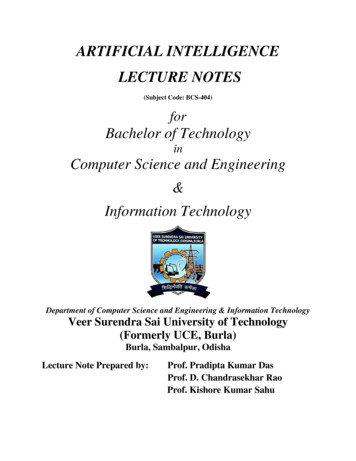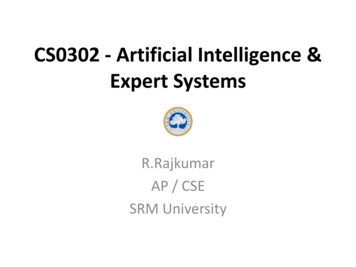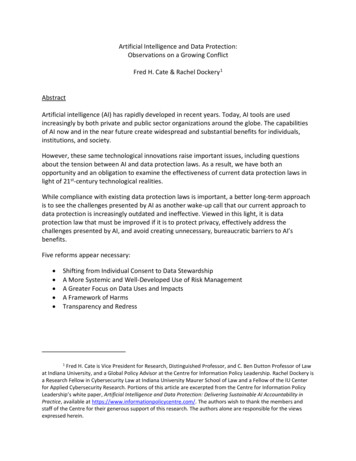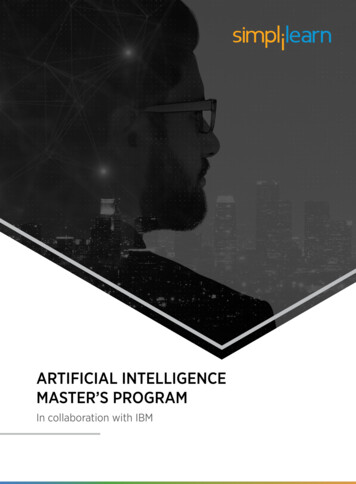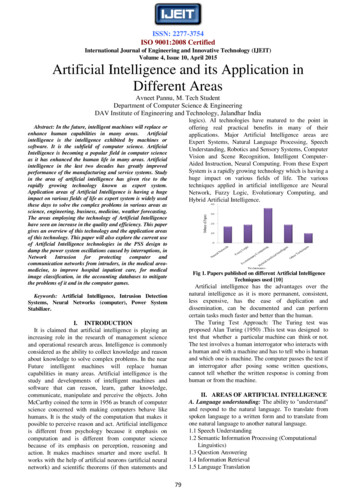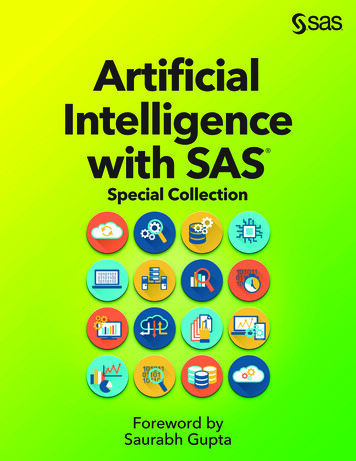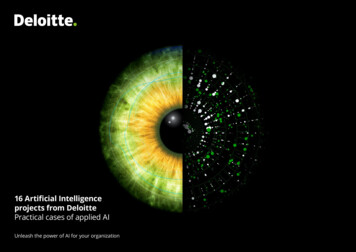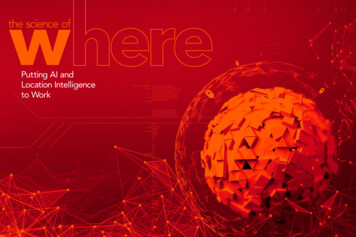
Transcription
the science ofPutting AI andLocation Intelligenceto Work
“AI is a data-driven game,hands down, but predictionswill be accurate only if thetraining data used to teachthe AI prediction model is trulyrepresentative of the targetcases being classified orpredicted. If I had to put it inone term, AI is basically ��Sud Menon, EsriMap Credit: Lisa Berry
Putting AI and Location Intelligence to WorkDecision-makers with access to the best informationHowever, recent leaps in computing power, increasinglyThis report examines the practical side of artificialset the standard for success.complex algorithms, and the enormous amount of dataintelligence, machine learning, and location intelligencegenerated as global digital transformation unfolds haveand discusses how organizations can use them to uncoverpushed AI from theory to everyday reality in many realms.business insight and realize digital transformation in aIn a recent survey by New Vantage Partners, C-levelrapidly evolving world. These technologies areexecutives singled out AI as the most disruptive technologyincreasingly applied in fields ranging from retail to health—far outranking cloud computing and blockchain.care to emergency management to manufacturing andAnd nearly 80 percent of those executives fear thatacross government. They are being used for drugcompetitors will harness AI to outflank their business.discovery, fraud detection, risk assessment, andToday’s corporate leaders crave information thatstrengthens their operations and guides strategicdecisions. In recent years, that quest has changed inways large and small. For one, information has neverbeen so abundant, and its ability to help executives seearound corners has never been so pronounced.Credit technological phenomena such as the Internet ofThings (IoT) and artificial intelligence (AI) for this shift:they are producing information of nearly incalculablebreadth and depth. In fact, some researchers say theworld has created as much data in the past year or twoas it has in all prior years of its existence.Yet data and information are commodities—plentiful butnot necessarily valuable in and of themselves. Amongexecutives, there’s a growing and profound recognitionthat insight, not mere information, is the new gold.For decades, the term artificial intelligence has beenemployed to embody life-changing promises aroundtechnology. First coined by Stanford professor JohnMcCarthy in 1955, AI has been a touchpoint for ourcollective imaginations, evoking visions ranging from robotsthat cook dinner to cars that drive themselves. For some,the constant exposure—and frequent underdelivery—has led to weariness around the topic of AI.1McKinsey Global Institute. Artificial Intelligence: The Next Digital Frontier. June 2017, p 9-12.manufacturing to bring down labor costs, reduceSome subsets of AI in particular have gained momentum.product deficit, and accelerate production.Machine learning (ML), deep learning, natural languageprocessing, and automation are all buzzwords of theMore broadly, executives are finding insight and thebusiness and technology sectors, and for good reason.competitive edge from data describing where thingsA 2017 McKinsey & Company report estimates thathappen, why they happen there, and how they canlarge technology companies made internal investmentsbe improved.in AI of between 18 billion and 27 billion in 2016.External investments, coming from venture capital andprivate equity, are estimated at 8 billion to 12 billionfor the same year. Of the external funding, machinelearning captured almost 60 percent of the investment.1In general, when organizations are powered byaccurate, up-to-the-second insight, risk is reduced,collaboration increases, executives make betterdecisions more quickly, and customer outcomesimprove across the board. uAs understanding of AI resolves into distinctsubgroups of technology, business leaders will have theopportunity to focus on the advances that mostpowerfully impact their organizations. Machine learningis a particularly exciting field that is shifting the horizonfor business executives.Some researchers say the world has created asmuch data in the past year or two as it has in allprior years of its existence. Yet data and informationare commodities—plentiful but not necessarilyvaluable in and of themselves.
Map Credit: Esri 3DCreative Thinking: Machines That LearnWithin world-class businesses, artificial intelligence toolsIndeed, a combination of machine learning and aAs with artificial intelligence, there is no single consensusA combination of machine learning and a geographicare ingesting the raw data of digital transformation andgeographic information system (GIS)—the backboneon a definition of machine learning. Dozens of expertsinformation system is particularly suited to running analysesIoT, combining it with location intelligence, and deliveringof location intelligence—is helping organizationshave offered their unique definitions. For the purposeson location data because of its ability to automate thenew kinds of insight.capture, store, and manage vast amounts of data; runof this report, Pedro Domingos explains ML succinctlyprediction, classification, and clustering of data.robust analysis; and then visualize insight embedded inin The Master Algorithm: “Computers aren’t supposedthat data.to be creative; they’re supposed to do what you tellMassive amounts of business and customer data arelinked to physical locations and times, and thousands ofthem to. If what you tell them to do is be creative, youThe following case studies delve deeper into the leadingedge of machine learning capabilities and their impactorganizations already analyze this location data to uncoverMachine learning uses data-driven algorithms that allowhidden intelligence—the kind of insight that can create acomputers to learn from data, recognize patterns, andcompetitive advantage. In many cases, machine learningcontinuously improve with experience. For example,One area where machine learning thrives is withinpowerful force behind critical business decisions—a form of artificial intelligence—powers that analysis.as raw images are fed into an algorithm, it begins tolocation intelligence. Massive amounts of data areand operations. uidentify patterns, and the accuracy of that patternlinked to a physical location and/or a moment in time.recognition increases over time. With enough dataThousands of organizations currently analyze locationinput, the computer builds up a highly accurate ability todata to uncover hidden insights—the kind oflabel components within images (house, car, cattle, stopinformation intelligence that creates a crucialsign), a skill that can be used to great effect, as showncompetitive edge. What many people don’t realizelater in a case study.is that ML powers much of that analysis.What’s new is that these technologies are growingsmarter and being applied to more use cases across thebusiness, from sales to fieldwork to the supply chain.get machine learning.”2on decision-making. As artificial intelligence accelerates,machine learning is making location intelligence aStory continues on page 62Domingos, Pedro. The Master Algorithm: How the Quest for the Ultimate Learning Machine Will RemakeOur World. Basic Books, a Member of the Perseus Books Group, 2018, p. xiv.
Strategic Location PlanningCase StudyMost businesses can be summed up as a series ofcrunches data associated with the population aroundwhat-if decisions—from planning quarterly initiativesa specific location—a prospective bank branch, forto anticipating which markets will be ripe forexample—and delivers a smart map showing that branch’sexpansion over the next decade. As the ultimatelikely audience. Recent breakthroughs in GIS and AI haveowners of those decisions, executives know all tooelevated the sophistication of that analysis, showingwell the perils of insufficient information. Now a newexecutives not just the branch’s geographic trade areaapplication of artificial intelligence (AI) is helpingbut its expected cost and anticipated revenue, too.them fill in critical gaps.In a retail landscape roiled by disruption, someFirst piloted in the financial services industry, the processexecutives are planning expansions, while others arehas broad applicability across commercial sectors. Itlooking to retrench. Insight—not just data—is key tocombines the elements of AI and location intelligencetheir planning. With a new methodology built onthat have drawn the attention of businesses worldwide:predictive power and speed, those executives arevast quantities of actionable spatial data, modern analyticalconducting the what-if scenarios that will help drivetechniques, and the domain expertise and culture totheir business forward.make data-driven decisions possible.Depending on their business objective, an executiveThe process uses location intelligence, AI, and predictivemight compare several potential retail sites, revealingcapabilities to show executives what kind of performancethe expected sales of each and determining the bestthey can expect from a retail location that has not yetpossible location. Or they can plot several locations asbeen built. Financial executives, for instance, can order aa network of branches, using the process to avoidfull-year revenue projection for a bank branch in a marketencroaching on any location’s sales and to understandthey’re evaluating and receive it in seconds.the revenue impact of the network as a whole.Until recent advances in artificial intelligence andToday’s what-if scenarios are growing increasinglycomputing, this brand of analysis was confined tosophisticated with the help of AI, computing capabilities,business mythology. Now, leading-edge companiesand GIS-driven location intelligence. Without this neware testing its capabilities and recognizing its potentialbrand of insight, business executives are left to planimpact on long-term business planning.major investments based on intuition and assumption. nThe new approach relies in part on drive-time analysis,which has been a feature of geographic informationsystem technology for years. Drive-time analysis
A New View: Automating Logistics WorkflowsOne burgeoning use case is with government regulators.Manufacturers can photograph their operations, creatingTraditionally, the government performs inspections ofa digital twin of factories. Using this digital copy of theirmany types on the ground, operation by operation. Dataphysical assets, they run simulations, track real-timecollected during visits may lead to violations, or tips maymovements within facilities, and capture data from sensorsdrive officials toward certain processing centers.placed throughout the factory. Embedded within a GISplatform, machine learning algorithms process the vastMachine learning, embedded within GIS, has allowedregulators to automate certain parts of inspectionprocesses, making them less labor intensive. The worldis now thoroughly documented by satellite imagery.amounts of data the twin captures, generating intelligencefor the manufacturer such as predictive maintenancerecommendations and alerts for unusual activity basedon pattern recognition.Using a GIS-powered platform, an ML algorithm is fedthousands of photos. As its “experience” increases, theImagery processing via machine learning touchesalgorithm learns to recognize patterns that signal illegalnumerous industries including agriculture, where droneactivity. Government officials can now systematically scanimagery of fields is common, and medicine, whereand then accurately identify which of these patterns maymachines are learning to read medical scans andbe in violation of regulations, all in a fraction of the timeidentify potential illness more accurately than theirtraditional inspections take.human counterparts. uStory continues on page 8Machine learning is especially good at recognizingpatterns within imagery. With an infinite store ofsatellite imagery available to businesses and the costof drone imagery plummeting, the possibilitiesbecome truly compelling.Imagery: Baton Rouge Infrared
Logistics—Deliveringto Meet ExpectationsCase StudyCompanies responsible for moving product todaily need up-to-the-moment insight. Without it,The ETA tool relies on a neural network—an AI enginecustomers know the value of speed, efficiency, anddrivers end up on circuitous, dead-end routes that robspecially designed to enlist massive computing powervisibility. They are at the beck and call of customers, whothe company—and its customers—of valuable time,in search of answers. ETA analyzes millions of historicalexpect faster delivery and constant visibility intofuel, and money.data points for each delivery route, including factors suchwhere purchases are in the delivery process.Now, a unique blend of IoT data, GIS-driven locationAn unprecedented coupling of technologies is givingintelligence, and AI-powered algorithms is deliveringcompanies just that kind of insight. With the locationthat insight. Using millions of GPS points from theintelligence of a geographic information system combinedcompany’s delivery vans, the road-snapping AI programwith sophisticated AI algorithms, pioneering manufacturersdetermines where unmarked or impassable roadsand logistics companies are perfecting their knowledgeare and updates the GIS technology so route plannersof road networks and improving their schedulingand drivers can avoid costly missteps.capabilities. These newfound capabilities help save timeand money while increasing customer satisfaction.For companies looking to boost customer satisfaction,the ability to determine accurate arrival times for goodsIn one example, a combined AI-GIS tool called roadisn’t merely a nice option to have. It’s a key differentiatorsnapping helps companies fill in knowledge gaps in roadin achieving more efficient and therefore more profitablenetworks. For remote areas where roads don’t alwaysoperations. Another tool called ETA, running on a similarappear on maps, and for densely packed locations whereblend of IoT data, location analysis, and AI, is producingsome roads close for construction and others open forthis kind of insight.the first time, companies that move delivery vehiclesas the origin and destination, whether it’s a weekend orholiday, the kind of vehicle involved, the products beingdelivered, and the road surfaces traveled. With computepower beyond a human’s capability, the tool turns thatbig data into a predicted arrival time with a high degreeof accuracy.In its 2017 State of Logistics report, the Council of SupplyChain Management Professionals and A.T. Kearney notedthat the cost of business logistics accounts for 7.5 percentof the US economy. While the bulk of that immense sumis simply the cost of doing business, a substantial portionof it is the result of waste. Now, mashups of IoT data,location intelligence, and artificial intelligence are pavinga new path to improved efficiency. n
Drive Safely:Individualized Premiums in the Insurance IndustryCar insurance premiums are typically based onCurrently, their premiums are calculated according toIf, for instance, a driver consistently makes small, quickThe ability to capture, manage, and analyze location-demographics—an amalgamation of characteristicsanalysis of general trends in their demographic groups.corrections on curved roads, the algorithms may identifybased big data is a particular strength of GIS andbased on age, gender, geographic location, and otherMachine learning allows organizations to tailorthat behavior as texting. That behavior identification ismachine learning. This combination has applicationsdata points. Over time, an individual’s premium may goexperiences to the individual rather than the average.based on the analysis of millions of data points from driversacross industries including logistics, manufacturing,across the country, which then allows the algorithm toretail, and finance. urecognize individual behaviors.Story continues on page 10up or down based on his or her driving record.One US-based insurance company is experimentingBut what if a 17-year-old male (with a high premium)with a new way of calculating premiums. By analyzingis a cautious driver, while a 45-year-old female (with adata from onboard accelerometers alongside GISNo texting? That driver will pay a lower premium. Thelow premium) has a bad habit of texting while drivingdata as cars move through space and time, an MLgranular nature of machine learning allows the insuranceto work?algorithm can recognize patterns in driver behaviorcompany to calculate individual, behavior-based premiums,including speeding and texting.rewarding drivers who operate vehicles safely.
Predicting Traffic Patterns and Preventing Traffic AccidentsCase StudyAnyone who’s attended a large sporting event understandsThe concept sounds simple, but at both ends of theof departing fans and spots areas where crowds areAt the heart of this smart-traffic solution is a modern GIS.the bittersweet feeling of a come-from-behind win. Withspectrum it’s deceptively complex. Using humanbeginning to form. Using location intelligence toGIS technology was among the first to incorporatethousands of fans engaged to the final whistle, the joy ofmonitors to oversee such large crowds can quicklyunderstand where traffic lights—connected to the IoT—artificial intelligence for predictive capabilities, deliveringvictory quickly becomes the agony of traffic as throngs ofbecome inefficient and overwhelming, and trusting thecan be adjusted to ease that congestion, the programheat maps to help companies detect areas of improvingfans emerge from the stadium on a select few paths: totask to technology demands sophisticated machinemakes the necessary adjustments in specific locationsor declining sales. That predictive prowess is now beingthe train station, to the interstate, or to nearby nightlife.learning algorithms.while keeping the whole system safe from slowdowns.combined with new forms of artificial intelligence toOne county in the southeastern United States is usingThe county and its partners are using trend detection,The project is an innovative private-public partnershipartificial intelligence, the IoT, and location technology toan advanced form of machine learning, as part of thebetween the county and the stadium owners, both ofimprove that experience. In cooperation with the stadiumsolution. Unlike the pattern recognition techniques thatwhich have a vested interest in moving pedestrian andowner in a large metropolitan area, the county is testinghave earned machine learning its notoriety—includingvehicle traffic smoothly through the city. Each groupa new system that enlists an intelligent algorithm todetecting cats and road signs in static images—thisbrings a critical piece of the puzzle to the machinemonitor street cameras and adjust traffic lights to regulatetechnique involves not just snapshots but also imageslearning solution: the county’s IoT-based camera networkpedestrian and vehicle flows.that change over time. In the stadium command center,combined with the sport team’s command center andthe machine learning algorithm analyzes real-time videoconnected infrastructure.enhance companies’ predictive power — and keepMap Credit: SunTrust, Cobb Countycrowds moving. n
By combining location intelligence andartificial intelligence, companies can bridgethe traditional gap between supply chainforecasting and actual consumer demand.Your Order Is Ready:Behavior Prediction in the Retail IndustryIn the retail industry, product is paramount, but“If I had to put it in one term,” Menon adds, “AI is basicallycustomer experience runs closely behind. In recentabout decision-making—smarter decision-making.”years, retail executives have broadened the definition ofcustomer experience beyond the traditional touchpoints.Retail leaders now focus on the many physical andsensory experiences customers have when they interactwith a retailer’s brand, store, and online and socialmedia presence.Forward-thinking retailers are finding ways to tap intothe data they need to be able to predict—with highlevels of accuracy—what customers are going todemand; when they want it; by what channel; and mostimportantly, where they want it available. By combininglocation intelligence and artificial intelligence, companiesBecause of these many touchpoints and the volume ofcan bridge the traditional gap between supply chaincustomer information generated by digital transformationforecasting and actual consumer demand.and the IoT, retail is especially ripe for machine learningapplications. Through recent innovations, machinelearning is helping retailers turn customer data—shared with the user’s permission—into insight thatdrives personalized experiences with their brand.In one scenario, customers who order a meal using aretailer’s app have their food handed to them at theexact moment they walk into the store.Today’s merchandise planning spans the entire complexnetwork in dynamic iterations that reflect real-timetrends. Predictive demand sensing backed by locationintelligence and AI gives companies the edge tocompete and build customer trust. Companies applythis innovative approach to deliver higher customersatisfaction, gain a competitive advantage, and achievehigher brand value.How is that level of precision possible? It is, in part, due tomachine learning’s predictive capabilities combined withcanny location intelligence. By analyzing millions of datapoints based on customer behavior and location datatracked through the app, ML algorithms can make accuratepredictions about when that customer will arrive—without the privacy-infringing practice of individuallocation tracking.“AI is a data-driven game, hands down,” explains Esri’sSud Menon. But “predictions will be accurate only if thetraining data used to teach the AI prediction model istruly representative of the target cases being classifiedor predicted.The customer experience can be enhanced throughmachine learning in other ways. Cities are already puttingGIS and ML to work directing drivers to the nearest openparking spaces in crowded urban areas. Large retailerscan provide in-app deals as a customer moves through astore, targeting incentives to their precise location andbehavior/purchasing history. u
“With some of theolder statisticalmethods, youreach a plateau interms of how muchvalue you gainout of data. But inthe newer deeplearning methods,the more data youthrow at it, themore value youkeep extracting outof that data. Wehaven’t yet reacheda theoreticalplateau in terms ofhow much valuecan be gained.”Shaping Tomorrow, TodayAI and machine learning are fueling a fundamental shiftin the way business leaders interact with their data,products, and customers, and this technology will onlycontinue to increase in sophistication and power. Deeplearning—a subset of ML that uses algorithms looselybased on the neural structure of the human brain—isat the forefront of artificial intelligence and also pairspowerfully with location intelligence.Alberto Nieto, a GIS and AI expert, explains theexcitement around ML and deep learning: “With someof the older statistical methods, you reach a plateau interms of how much value you gain out of data. But in thenewer deep learning methods, the more data you throwat it, the more value you keep extracting out of thatdata. We haven’t yet reached a theoretical plateau interms of how much value can be gained.”As digital transformation continues to accelerate and thedata produced by IoT grows, business executives facethe tantalizing prospect of deriving even more valuefrom data analysis. From an executive’s perspective, nowis the time to answer critical questions: What is AI, whatcan it do for my business, and who should be responsiblefor its development and strategic alignment?Today, business leaders have the opportunity to makestrategic investments in emerging facets of artificialintelligence. These decisions will ultimately help them—Alberto Nieto, a GIS and Machine Learning Engineerunleash the insight-generating power of AI andlocation intelligence across their organizations.Organizations that best understand how to apply thesetechnologies—not just for the sake of using them but tohelp them meet their goals at a fundamental level—willsucceed and prosper. n
About EsriEsri, the global market leader in location intelligence, offersthe most powerful mapping and spatial analytics technologyavailable. Since 1969, Esri has helped customers unlock thefull potential of data to improve operational and businessresults. Today, Esri software is deployed in more than 350,000organizations including the world’s largest cities, mostnational governments, 75 percent of Fortune 500 companies,and more than 7,000 colleges and universities. Esri engineersthe most advanced solutions for digital transformation, theInternet of Things (IoT), and location analytics to inform themost authoritative maps in the world.Learn more atesri.com/AIMap and Imagery Sources and Credits: Esri, US Census Bureau, American Community Survey (ACS), Table B19001,City of Philadelphia, Zoning Code Commission (ZCC), HERE, Garmin, FAO, NOAA, USGS, NAIP, USDA, FSA, NASA OpenStreetMap contributors, and the GIS User Community.Map Credit: City of Philadelphia, Zoning Code Commission (ZCC)Copyright 2018 Esri. All rights reserved. Esri, the Esri globe logo, The Science of Where, @esri.com, and esri.comare trademarks, service marks, or registered marks of Esri in the United States, the European Community, or certainother jurisdictions. Other companies and products or services mentioned herein may be trademarks, service marks,or registered marks of their respective mark owners.G160065For more information,please contactEsri380 New York StreetRedlands, California 92373-81001 800 447 9778T909 793 2853F909 793 5953info@esri.comesri.comUSA
Copyright 2018 Esri. All rights reserved.
AI is a data-driven game, hands down, but predictions will be accurate only if the training data used to teach the AI prediction model is truly representative of the target cases being classified or predicted. If I had to put it in one term, AI is basically about decision-making—smarter decision-making

